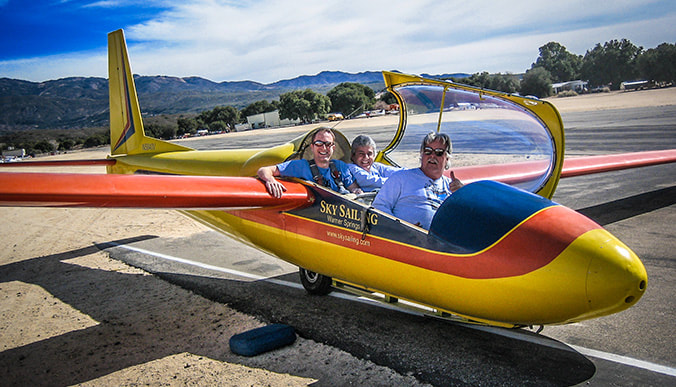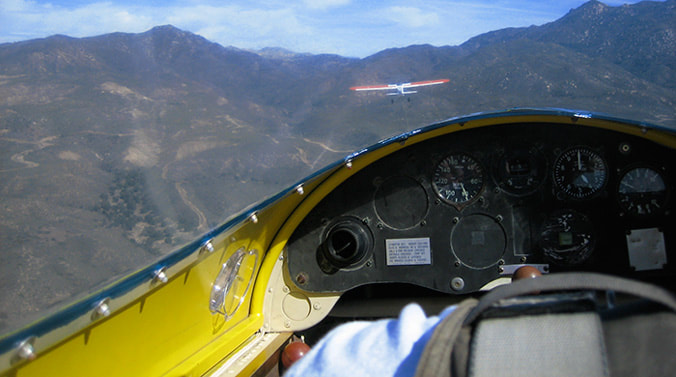|
Los Angeles traffic feels like a stuffy nose. Sitting in bumper-to-bumper traffic on the 405, or the 10, or the 91, you start wishing for a cosmic tissue to blow away the insufferable congestion. Eventually the jams peter out on the I-15, disappearing on Highway 79 South altogether. At last, some tumbleweed! My car slices through rolling brown hills that seem familiar from Hollywood westerns. Up ahead is the Warner Springs Airstrip, a saloon for modern sky sailors. We are here to tick off sailplaning, or sky sailing, or soaring, or whatever you want to use to describe the act of gliding a fibreglass dragonfly in the dreamy California sky. Lining the airstrip are white coffin-shaped boxes containing easy-to-assemble sailplanes. Although fixed-wing gliding has been around since the Wright Brothers, the aircraft took off recreationally after World War II, when Germans were restricted to flying non-powered planes. Modern German-built gliders, withstand more pressure than fighter jets, have reached over 13,000 metres in altitude, and covered an incredible 2250 kilometres. It is said that the best pilots in the world are avid gliders, capable of feeling the winds beneath their wings. Case in point: when a section of a fuselage blew out, a pilot named Dave Cronin credited his gliding skills with saving all aboard his Boeing 747. Good to know as I cram into my seat behind the sailplane pilot. We are connected to a small prop plane with a sixty-metre metal tow wire. It’s a bumpy take-off, the glider rattling and flexing on the ground with the grace of a running swan. My nerves start to shake with the seat. Unless one is prepared to invest $300,000 for a new state-of-the-art Stemme, most gliders are designed for thrills over comfort. Before the tow-plane even leaves tarmac, our glider lifts gently into the air, tuned up and eager for altitude. The swan elegantly takes flight. Once we reach one thousand metres, the pilot signals me to pull a lever and cut our umbilical cord to the plane. Suddenly, I am inside the eye of an albatross. Much like hanggliding or paragliding, sailplane pilots hunt warm pockets of air called thermals in order to gain elevation. Each pocket of warm air results in a dramatic upwards swing. Safely strapped in, there’s not enough room in the cockpit for too much bouncing around from the turbulence. Air gushes in from breathing holes on the sides, which I open up all the way in case of motion sickness. This increases the noise level, but takes nothing away the thrill of pure flight. No engines, no fuel – just air currents, speed and grace. “Do you want to see what this baby can do?” asks the pilot. That’s usually a rhetorical question, one I’ve been asked several times researching this Bucket List, and one I have never yet answered in the affirmative. Dave Cronin suddenly nosedives the sailplane and there is so much blood rushing to my head it might just explode. He's pulling a David Cronenberg! You know that moment when you’re on a rollercoaster and wonder if you’re going to fall out? When you pull tricks in a sailplane, that moment doesn’t stop. The speed and pressure is incredible, increased as the pilot points the nose upwards, giving us the sensation of negative G-force. Weightless for a moment, his walkie-talkie floats above our heads. Worth noting at this point is the volume of my screaming, and the fact that I am wondering if vomit can cleanly squeeze through the diameter of the breathing holes. We level out, and after a twenty-five minute ride, land on the runway, speed along to the main office, and come to an abrupt stop. Gravity feels especially heavy, but there’s some relief when my feet touch the ground. Unfortunately, I’ll have to use those feet for the drive back to Los Angeles, where soaring is strictly reserved for the imaginations of would-be starlets. For more info, including directions, weather and rates, visit: www.skysailing.com
1 Comment
10/8/2021 05:20:13 am
Excellent article! Your post is essential today. Thanks for sharing, by the way.If you are looking for coupon codes and deals just visit coupon plus deals dot
Reply
Your comment will be posted after it is approved.
Leave a Reply. |
Greetings.
Please come in. Mahalo for removing your shoes. After many years running a behemoth of a blog called Modern Gonzo, I've decided to a: publish a book or eight, and b: make my stories more digestible, relevant, and deserving of your battered attention. Here you will find some of my adventures to over 100 countries, travel tips and advice, rantings, ravings, commentary, observations and ongoing adventures. Previously...
July 2024
Categories
All
|



 RSS Feed
RSS Feed

